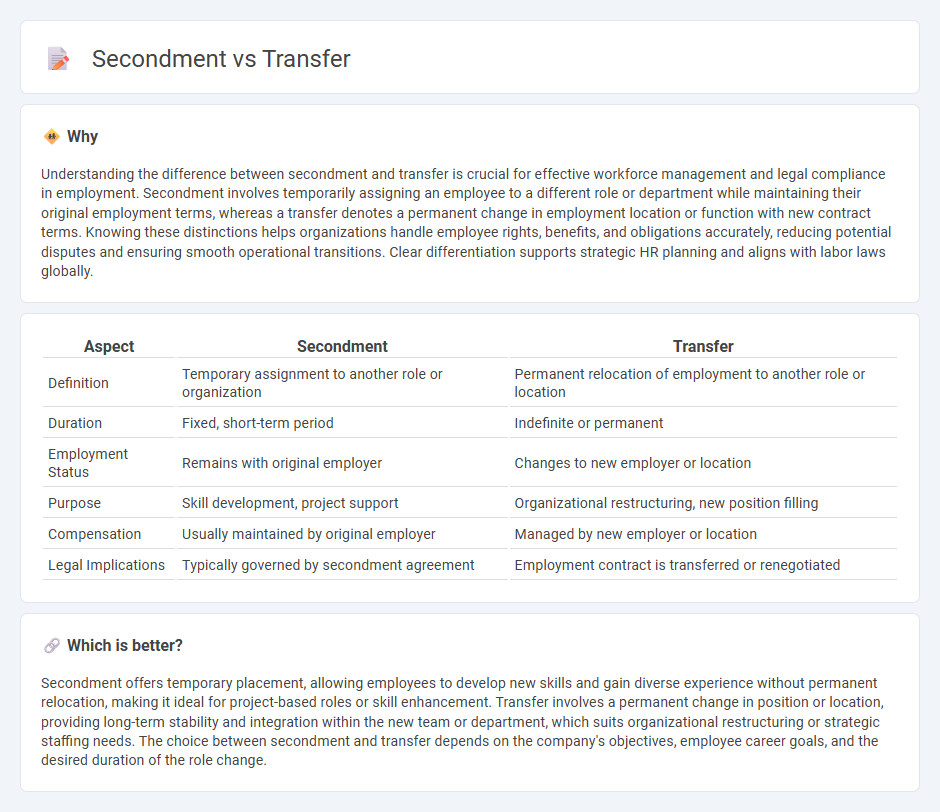
Secondment involves temporarily assigning an employee to a different role or department within the same organization, often to gain new skills or fill a short-term need. Transfer typically denotes a permanent change of position or location within the company, affecting the employee's employment contract and benefits. Discover more about the strategic implications and operational differences between secondment and transfer.
Why it is important
Understanding the difference between secondment and transfer is crucial for effective workforce management and legal compliance in employment. Secondment involves temporarily assigning an employee to a different role or department while maintaining their original employment terms, whereas a transfer denotes a permanent change in employment location or function with new contract terms. Knowing these distinctions helps organizations handle employee rights, benefits, and obligations accurately, reducing potential disputes and ensuring smooth operational transitions. Clear differentiation supports strategic HR planning and aligns with labor laws globally.
Comparison Table
| Aspect | Secondment | Transfer |
|---|---|---|
| Definition | Temporary assignment to another role or organization | Permanent relocation of employment to another role or location |
| Duration | Fixed, short-term period | Indefinite or permanent |
| Employment Status | Remains with original employer | Changes to new employer or location |
| Purpose | Skill development, project support | Organizational restructuring, new position filling |
| Compensation | Usually maintained by original employer | Managed by new employer or location |
| Legal Implications | Typically governed by secondment agreement | Employment contract is transferred or renegotiated |
Which is better?
Secondment offers temporary placement, allowing employees to develop new skills and gain diverse experience without permanent relocation, making it ideal for project-based roles or skill enhancement. Transfer involves a permanent change in position or location, providing long-term stability and integration within the new team or department, which suits organizational restructuring or strategic staffing needs. The choice between secondment and transfer depends on the company's objectives, employee career goals, and the desired duration of the role change.
Connection
Secondment and transfer are connected as both involve the temporary or permanent relocation of an employee within or between organizations to fulfill specific job roles. Secondment typically refers to a temporary assignment to another department or company, allowing skill development and knowledge exchange without changing the employee's primary employer. Transfer, by contrast, usually denotes a permanent move, altering the employee's official work location or department within the same organization.
Key Terms
Employer-Employee Relationship
Transfer involves a permanent change in the employee's position or location within the same organization, maintaining the original employment contract and relationship. Secondment typically refers to a temporary assignment to another department, subsidiary, or external organization, where the employee retains their original employer but works under a different supervisory structure. Explore the key distinctions to optimize workforce management and legal compliance.
Control and Supervision
Control and supervision in transfers typically rest with the receiving organization, where the employee adapts to new management protocols and operational standards. In secondments, the employee remains under the control of the original employer while performing duties at the host organization, often splitting supervision responsibilities. Explore key differences in control and supervision between transfer and secondment for better organizational alignment.
Legal Liability
Legal liability in transfers often remains with the original employer until the transfer is fully executed, safeguarding both parties during the transition. In secondments, liability typically continues to rest with the seconding employer, even as the employee works under the host organization's supervision. Explore detailed legal frameworks and case studies to understand the nuances of employer responsibilities in transfers versus secondments.
Source and External Links
Transfer - Vocabulary.com - The term "transfer" refers to the act of moving something from one place to another, such as transferring money between accounts.
Transfer - Cambridge English Dictionary - "Transfer" means to move someone or something from one place, vehicle, person, or group to another.
Dropbox Transfer - Dropbox Transfer allows users to securely deliver large files to anyone and track downloads.
 dowidth.com
dowidth.com